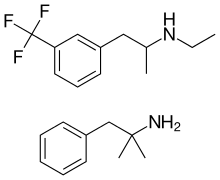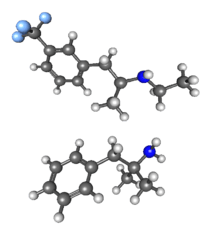Fenfluramine/phentermine
The drug combination fenfluramine/phentermine, usually called fen-phen, was an anti-obesity treatment that utilized two anorectics. Fenfluramine was marketed by American Home Products (later known as Wyeth) as Pondimin, but was shown to cause potentially fatal pulmonary hypertension and heart valve problems, which eventually led to its withdrawal and legal damages of over $13 billion.[1] Phentermine was not shown to have harmful effects.[1]
 | |
 | |
| Combination of | |
|---|---|
| Fenfluramine | Serotoninergic |
| Phentermine | Adrenergic, dopaminergic, serotoninergic |
| Clinical data | |
| Pregnancy category |
|
| Routes of administration | Oral |
| ATC code |
|
| Legal status | |
| Legal status |
|
| (verify) | |
Fenfluramine acts as a serotonin releasing agent,[2] phentermine as primarily a norepinephrine releasing agent. Phentermine also induces the release of serotonin and dopamine, although to a far lesser extent than it induces the release of norepinephrine.[3]
History
Fenfluramine as a single drug was first introduced in the 1970s, but was not popular because it only temporarily reduced weight.[1] A 1984 study found a weight loss of 7.5 kg on average in 24 weeks, as compared to 4.4 kg under placebo.[4] It sold modestly until the 1990s, when it was combined with phentermine and heavily marketed.[1] A similar drug, aminorex, had caused severe lung damage and "provided reason to worry that similar drugs ... could increase the risk of a rare but often fatal lung disease, pulmonary hypertension."[1] In 1994, Wyeth official Fred Wilson expressed concerns about fenfluramine's labeling containing only four cases of pulmonary hypertension when a total of 41 had been observed, but no action was taken until 1996.[1] In 1995, Wyeth introduced dexfenfluramine (the dextro isomer, marketed as Redux), which it hoped would cause fewer adverse effects. However, the medical officer of the Food and Drug Administration (FDA), Leo Lutwak, insisted upon a black box warning of pulmonary hypertension risks. After Lutwak refused to approve the drug, the FDA management had James Milton Bilstad, FDA Senior Drug Evaluator, sign it and approved the drug with no black box warning for marketing in 1996.[1] European regulators required a major warning of pulmonary hypertension risks.[1]
In 1996, a 30-year-old woman developed heart problems after a month of using fenfluramine/phentermine; when she died in February 1997, the Boston Herald devoted a front-page article to her.[5] Later that year, in August 1997, a paper in the New England Journal of Medicine (NEJM) from the Mayo Clinic discussed clinical findings in 24 people who had taken fen-phen. The authors noted that their findings suggested a possible correlation between mitral valve dysfunction and the use of these anorectic agents.[6] The FDA alerted medical doctors that it had received nine additional reports of the same type, and requested all health care professionals to report any such cases to the agency’s MedWatch program, or to their respective pharmaceutical manufacturers. The FDA subsequently received over a hundred additional reports of valvular heart disease in people taking fen-phen, fenfluramine alone or dexfenfluramine alone.[7] The FDA requested that the manufacturers of fenfluramine and dexfenfluramine stress the potential risk to the heart in the drugs' labeling and in package inserts.[8] As of 1997, the FDA was continuing to receive reports of valvular heart disease in persons who had taken these drugs. This disease typically involves the aortic and mitral valves.
After reports of valvular heart disease and pulmonary hypertension, primarily in women who had been undergoing treatment with fen-phen or (dex)fenfluramine, the FDA requested its withdrawal from the market in September 1997.[7][9]
The action was based on findings from doctors who had evaluated people taking these two drugs with echocardiograms, a procedure that can test the functioning of heart valves. The findings indicated that approximately 30 percent of people who had taken the combination up to 24 months had abnormal echocardiograms, even though they had no symptoms. This percentage of abnormal test results was much higher than would be expected from a comparatively sized sample of the population who had not been exposed to either fenfluramine or dexfenfluramine.[6][10] Follow up studies showed that for people who took the combination for 3 months or less, the rate of heart valve complications was less than 3%.[10]
Aftermath
Upon the release of the information regarding fen-phen's cardiac risks, the Association of Trial Lawyers of America formed a large trial lawyer group to seek damages from American Home Products, the distributor of fenfluramine and dexfenfluramine.[11]
Fen-phen is no longer widely available. In April 2005, American Lawyer magazine ran a cover story on the wave of fen-phen litigation, reporting that more than 50,000 product liability lawsuits had been filed by alleged fen-phen victims. Estimates of total liability ran as high as $14 billion. As of February 2005, Wyeth was still in negotiations with injured parties, offering settlements of $5,000 to $200,000 to some of those who had sued, and stating they might offer more to those who were most seriously injured.[12] One plaintiff's attorney claimed that "the payments [were] not going to be large enough to cover medical expenses."[13] Thousands of injured persons rejected these offers.[12] At the time, Wyeth announced it has set aside $21.1 billion (U.S.) to cover the cost of the lawsuits.[12]
Possible uses
Obesity
In 1984, researchers at the University of Rochester Medical Center reported that they had performed a double-blind, controlled clinical trial comparing phentermine alone, fenfluramine alone, a combination of phentermine and fenfluramine, and placebo, for weight loss in humans. Weight loss in those receiving the fen-phen combination was significantly greater (8.4±1.1 kg) than in those receiving placebo (4.4±0.9 kg) and equivalent to that of those receiving fenfluramine (7.5±1.2 kg) or phentermine alone (10.0±1.2 kg). This amounts to an additional weight loss of 4±2 kg over the course of 24 weeks. Adverse effects were less frequent with the combination regimen than with the other active (non-placebo) treatments. The authors felt that combining fenfluramine and phentermine capitalized on their pharmacodynamic differences, resulting in equivalent weight loss, fewer adverse effects, and better appetite control.[4]
Addiction
The term fen-phen was coined in 1994 when Pietr Hitzig and Richard B. Rothman reported that this combination could presumptively remit alcohol and cocaine craving. The authors suggested that other combined dopamine and serotonin agonists or precursors might share this therapeutic potential.[14][15] Subsequent experiments in rats supported these preliminary reports.[16][17] In 2006 it was confirmed that the combination of phentermine and the serotonin precursor 5-hydroxytryptophan (5-HTP), in place of fenfluramine, significantly decreased alcohol withdrawal seizures in rats.[18]
Intramural National Institutes of Health (NIH) double-blind protocols to demonstrate the efficacy of fen-phen in alcohol and cocaine addiction were designed,[19] but never performed.
Adverse effects
The findings on fen-phen, specifically fenfluramine, causing valvular heart disease and pulmonary hypertension prompted a renewed interest in the deleterious effects of systemic serotonin. It had already been known for decades that two of the major side-effects of the carcinoid syndrome, in which excessive serotonin is produced endogenously, are valvular disease and pulmonary hypertension. Several centers were able to note a relationship to an excessive activation of the serotonin receptor subtype 5-HT2B.[20][21]
References
- Avorn J. (2004). Powerful Medicines, pp. 71-84. Alfred A. Knopf.
- Nestler, Eric J. "Molecular Neuropharmacology: A Foundation for Clinical Neuroscience" McGraw-Hill, 2001.
- Rothman, R. B.; Baumann, M. H.; Dersch, C. M.; Romero, D. V.; Rice, K. C.; Carroll, F. I.; Partilla, J. S. (2001). "Amphetamine-type central nervous system stimulants release norepinephrine more potently than they release dopamine and serotonin". Synapse. 39 (1): 32–41. doi:10.1002/1098-2396(20010101)39:1<32::AID-SYN5>3.0.CO;2-3. PMID 11071707.
- Weintraub, M.; Hasday, J. D.; Mushlin, A. I.; Lockwood, D. H. (1984). "A double-blind clinical trial in weight control. Use of fenfluramine and phentermine alone and in combination". Archives of Internal Medicine. 144 (6): 1143–1148. doi:10.1001/archinte.144.6.1143. PMID 6375610.
- Hayward, Ed (6 May 1997). "Diet to Death". Boston Herald. p. 1. Retrieved 3 September 2009.
- Connolly, H. M.; Crary, J. L.; McGoon, M. D.; Hensrud, D. D.; Edwards, B. S.; Edwards, W. D.; Schaff, H. V. (1997). "Valvular Heart Disease Associated with Fenfluramine–Phentermine". New England Journal of Medicine. 337 (9): 581–588. doi:10.1056/NEJM199708283370901. PMID 9271479.
- Centers for Disease Control and Prevention (CDC) (1997). "Cardiac valvulopathy associated with exposure to fenfluramine or dexfenfluramine: U.S. Department of Health and Human Services interim public health recommendations, November 1997". MMWR. Morbidity and Mortality Weekly Report. 46 (45): 1061–1066. PMID 9385873.
- ""Fen-Phen" Update (Fenfluramine, Phentermine, Dexfenfluramine)". web.archive.org. 2009-11-04. Retrieved 2019-04-19.
- "Press release: FDA Announces Withdrawal Fenfluramine and Dexfenfluramine (Fen-Phen)". FDA. September 15, 1997. Archived from the original on 4 November 2009.
- Weigle, DS (June 2003). "Pharmacological therapy of obesity: past, present, and future". The Journal of Clinical Endocrinology and Metabolism. 88 (6): 2462–9. doi:10.1210/jc.2003-030151. PMID 12788841.
- "After Fen-Phen", Karen Springen and Geoffrey Cowley, Newsweek, September 29, 1997
- New York Times: Fen-Phen Case Lawyers Say They'll Reject Wyeth Offer, Feb. 17, 2005.
- Morrow, David J. (8 October 1999). "Fen-Phen Maker to Pay Billions In Settlement of Diet-Injury Cases". The New York Times.
- Hitzig, P. (1994). "Combined serotonin and dopamine indirect agonists correct alcohol craving and alcohol-associated neuroses" (PDF). Journal of Substance Abuse Treatment. 11 (5): 489–490. doi:10.1016/0740-5472(94)90103-1. PMID 7869471.
- Rothman, R. B.; Gendron, T.; Hitzig, P. (1994). "Hypothesis that mesolimbic dopamine (DA) plays a key role in mediating the reinforcing effects of drugs of abuse as well as the rewarding effects of ingestive behaviors". Journal of Substance Abuse Treatment. 11 (3): 273–275. doi:10.1016/0740-5472(94)90086-8. PMID 8072057.
- Yu, Y. L.; Fisher, H.; Sekowski, A.; Wagner, G. C. (1997). "Amphetamine and fenfluramine suppress ethanol intake in ethanol-dependent rats". Alcohol (Fayetteville, N.Y.). 14 (1): 45–48. doi:10.1016/s0741-8329(96)00110-3. PMID 9014023.
- Glatz, A. C.; Ehrlich, M.; Bae, R. S.; Clarke, M. J.; Quinlan, P. A.; Brown, E. C.; Rada, P.; Hoebel, B. G. (2002). "Inhibition of cocaine self-administration by fluoxetine or d-fenfluramine combined with phentermine". Pharmacology Biochemistry and Behavior. 71 (1–2): 197–204. doi:10.1016/S0091-3057(01)00657-8. PMID 11812523.
- Halladay, A. K.; Wagner, G. C.; Sekowski, A.; Rothman, R. B.; Baumann, M. H.; Fisher, H. (2006). "Alterations in alcohol consumption, withdrawal seizures, and monoamine transmission in rats treated with phentermine and 5-hydroxy-L-tryptophan". Synapse. 59 (5): 277–289. doi:10.1002/syn.20239. PMID 16416445.
- https://sites.google.com/site/pietrhitzig/Home/reference-manager/reference-manager/NIDA_DIR_266.pdf?attredirects=0
- Rothman, R. B.; Baumann, M. H.; Savage, J. E.; Rauser, L.; McBride, A.; Hufeisen, S. J.; Roth, B. L. (2000). "Evidence for possible involvement of 5-HT(2B) receptors in the cardiac valvulopathy associated with fenfluramine and other serotonergic medications". Circulation. 102 (23): 2836–2841. doi:10.1161/01.CIR.102.23.2836. PMID 11104741.
- Hutcheson, J. D.; Setola, V.; Roth, B. L.; Merryman, W. D. (2011). "Serotonin receptors and heart valve disease—It was meant 2B". Pharmacology & Therapeutics. 132 (2): 146–57. doi:10.1016/j.pharmthera.2011.03.008. PMC 3179857. PMID 21440001.
External links
- Frontline: Dangerous prescriptions – Interview with Leo Lutwak, in which he discusses the side effects of fenfluramine (Pondimin), its successor dexfenfluramine (Redux), and the fen-phen combination.
- U.S. FDA fen-phen information
- Tellier, P. (2001). "Fenfluramines, idiopathic pulmonary primary hypertension and cardiac valve disorders: Facts and artifacts". Annales de médecine interne. 152 (7): 429–436. PMID 11965083.